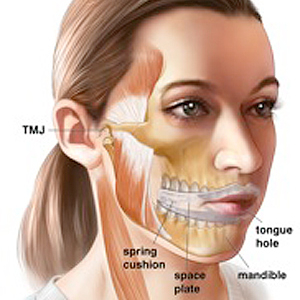
Additional Conditions
TMJ, Migraine Headaches & Joint Disorders
TMJ, Migraine Headaches & Joint Disorders

The temporomandibular (tem-puh-roe-mun-DIB-u-lur) joint (TMJ) acts like a sliding hinge, connecting your jawbone to your skull. TMJ disorders can cause pain in your jaw joint and in the muscles that control jaw movement.
The exact cause of a person’s TMJ disorder is often difficult to determine. Your pain may be due to a combination of problems, such as arthritis or jaw injury. Some people who have jaw pain also tend to clench or grind their teeth, but many people habitually clench their teeth and never develop TMJ disorders.
In most cases, the pain and discomfort associated with TMJ disorders can be alleviated with self-managed care or nonsurgical treatments. Severe TMJ disorders may require surgical repair.
A migraine headache can cause intense throbbing or a pulsing sensation in one area of the head and is commonly accompanied by nausea, vomiting, and extreme sensitivity to light and sound. Migraine attacks can cause significant pain for hours to days and be so severe that all you can think about is finding a dark, quiet place to lie down. Some migraines are preceded or accompanied by sensory warning symptoms (aura), such as flashes of light, blind spots, or tingling in your arm or leg.
 Symptoms
SymptomsMigraine headaches often begin in childhood, adolescence or early adulthood. Migraines may progress through four stages, including prodrome, aura, headache and postdrome, though you may not experience all the stages.
Prodrome
One or two days before a migraine, you may notice subtle changes that signify an oncoming migraine, including:
Aura
Aura may occur before or during migraine headaches. Auras are nervous system symptoms that are usually visual disturbances, such as flashes of light. Sometimes auras can also be touching sensations (sensory), movement (motor) or speech (verbal) disturbances. Most people experience migraine headaches without aura. Each of these symptoms usually begins gradually, builds up over several minutes, and then commonly lasts for 20 to 60 minutes. Examples of aura include:
Attack
When untreated, a migraine usually lasts from four to 72 hours, but the frequency with which headaches occur varies from person to person. You may have migraines several times a month or much less often. During a migraine, you may experience the following symptoms:
Postdrome
The final phase, known as postdrome, occurs after a migraine attack. During this time you may feel drained and washed out, though some people report feeling mildly euphoric.
 When to see a doctor
When to see a doctorMigraine headaches are often undiagnosed and untreated. If you regularly experience signs and symptoms of migraine attacks, keep a record of your attacks and how you treated them. Then make an appointment with your doctor to discuss your headaches.
Even if you have a history of headaches, see your doctor if the pattern changes or your headaches suddenly feel different.
See your doctor immediately or go to the emergency room if you have any of the following signs and symptoms, which may indicate other, more serious medical problems:
